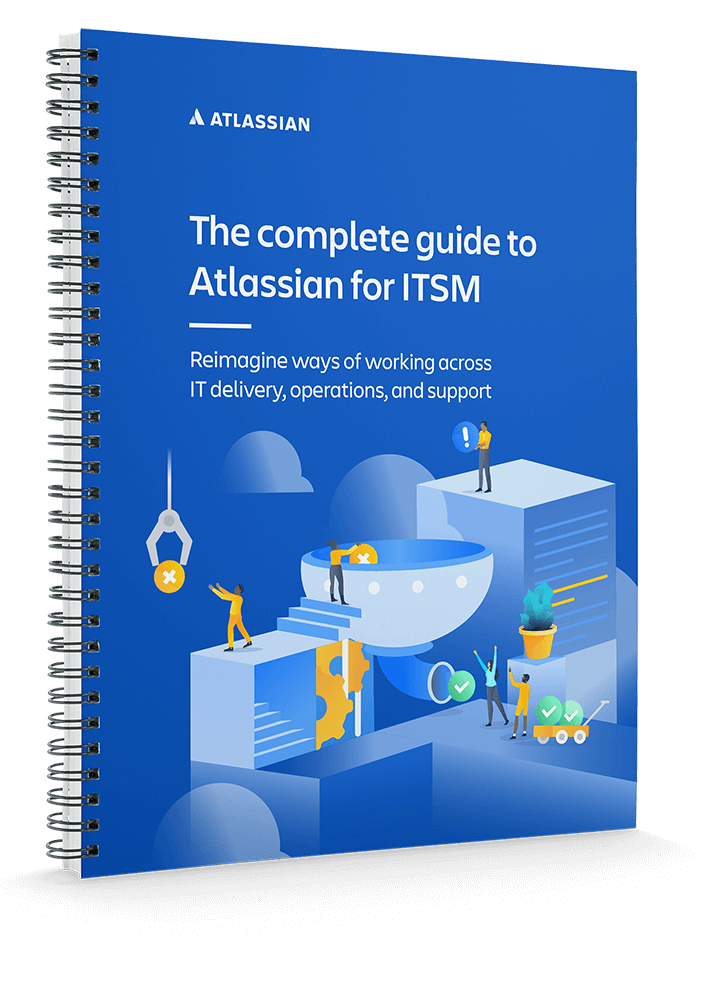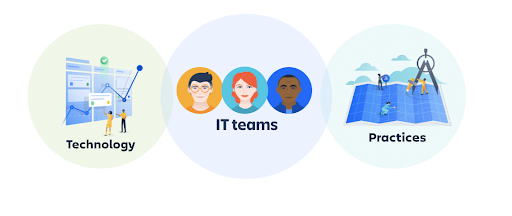ITSM for high-velocity teams
What is IT Service Management (ITSM)?
IT service management -- often referred to as ITSM -- is simply how IT teams manage the end-to-end delivery of IT services to customers. This includes all the processes and activities to design, create, deliver, and support IT services.
The core concept of ITSM is the belief that IT should be delivered as a service. A typical ITSM scenario could involve asking for new hardware like a laptop. You would submit your request through a portal, filling out a ticket with all relevant information, and kicking off a repeatable workflow. Then, the ticket would land in the IT team’s queue, where incoming requests are sorted and addressed according to importance.

Atlassian for ITSM
The basics you need to know about ITSM with Atlassian – across IT delivery, operations, and support, plus best practices and tips.
Due to their day-to-day interactions with IT, people often misconstrue ITSM as basic IT support. On the contrary, ITSM teams oversee all kinds of workplace technology, ranging from laptops, to servers, to business-critical software applications.
There is a common line of thinking in the IT industry that posits that a proper approach to ITSM should follow three steps in this order: 1) Build and implement IT technology. 2) Bring in and enforce the right process. 3) People can learn the technology and abide by the process. Atlassian flips that paradigm.

For us, the team comes first. We've even created a team playbook to provide tools that help teams improve the way they work. IT teams should be continually learning and improving. They must feel valued and empowered to make a difference in the organization. Rather than answering to rules imposed by a tiered reporting structure or rigid process, IT teams can make informed decisions about things like adopting SLAs and which software to implement. Because IT teams enable productivity and digital transformation, strong IT teams are critical to strong organizations. The team is at the center of ITSM processes and technologies.
After focusing on the strength of the IT team, it’s possible to develop the unique practices and capabilities to provide value to the organization. No matter how respectable the source, it’s insufficient to simply “copy and paste” another organization’s set of standards and hope they will work in your unique environment. Successful IT teams build their approach from frameworks like ITIL (the Information Technology Infrastructure Library), but are careful to think about how to adapt processes that will resonate with their customers.
Finally, software and technology should support a team’s practices and amplify their impact. Good ITSM software helps IT reach others in their organizations with cross-team collaboration. It empowers end-users and automates mundane work, so everyone gets more time to focus on what matters most to them. We’ve all seen technology get in the way and create unnecessary complexity or frustration. When technology works well it feels like magic, but in reality, it’s a reflection of the hard work of the teams that use it.
ITSM vs ITIL vs DevOps
IT teams leverage a variety of frameworks to guide their work. The most common ones we hear about are ITSM and DevOps, though there are numerous other concepts, like COBIT, SIAM, IT4IT, lean, and the list continues...
So what abbreviations do you need to know? Here we’ll cover two of the most influential frameworks for modern IT teams-- ITSM and DevOps-- along with a common approach to ITSM. Let’s start by defining some key terms.
ITSM
As mentioned above, IT Service Management is simply how IT teams manage the delivery of IT services to customers. A team’s approach to ITSM can be structured to align with ITIL practices and influenced by DevOps concepts.
ITIL
ITIL is the most widely accepted approach to ITSM. ITIL focuses on practices for aligning IT services with business needs. ITIL can help organizations adapt to ongoing transformation and scale. ITIL 4, the recent update to ITIL standards, represents a paradigm shift for IT teams. It guides teams to a holistic, business and customer-value frame of reference, and encourages a more flexible approach based on how your team works. The ITIL 4 Guiding Principles promote collaboration, simplicity, and feedback.
ITIL is sometimes misrepresented as “the rules,” rather than guidance, that is open for interpretation. Yet, just because we need to use process and document work, doesn’t mean we should generate cumbersome masses of records and bureaucratic overhead. There is no excuse for hiding behind processes or the ITIL “rules.”
DevOps
DevOps emphasizes accelerated IT service delivery enabled by agile and lean practices. DevOps improves collaboration between development and IT operations teams, so organizations can build, test, and release software faster and more reliably. The promised benefits include increased trust, faster software releases, an ability to solve critical issues quickly, and better management of unplanned work.
Though DevOps includes continuous development, integration, and automated delivery, the concept is founded on building a culture of collaboration between teams that historically functioned in relative siloes. Much of the context and ethos behind DevOps is about moving away from old divisions and working together – collaboratively. Unfortunately, this is often seen as pertaining just to ‘Dev’ and not ‘Ops’.
ITSM and DevOps are typically pitched against each other, as an ‘either/or’ decision – “we are an ITSM or a DevOps house.” There is confusion about what ITSM and DevOps deliver and how they could work together. Modern, high performing teams realize that they need to both be able to work smarter and quicker, but still require process and control.
It’s time to move beyond the ITSM vs DevOps ultimatum and use elements of both - whether you explicitly follow frameworks or not. DevOps is much more than just automated development, and promotes the importance of collaboration and a blame-free culture. Moreover, ITSM and the ITIL approach shouldn't be pigeonholed as an administrative burden, but used in an agile way to fit the unique needs of different organizations.
The importance of ITSM
ITSM benefits your IT team, and service management principles can improve your entire organization. ITSM leads to efficiency and productivity gains. A structured approach to service management also brings IT into alignment with business goals, standardizing the delivery of services based on budgets, resources, and results. It reduces costs and risks, and ultimately improves the customer experience.
We’ve found some of the most common benefits of ITSM to include:
- Aligning IT teams with business priorities tracked through success metrics
- Enabling cross-department collaboration
- Bringing IT teams and development teams together through streamlined project management approaches
- Empowering IT teams to share knowledge and continuously improve
- Improving request coordination for more efficient service
- Promoting customer-centricity with self-service and better processes
- Responding more quickly to major incidents, and preventing future ones
All of which decrease costs and lead to better service.
ITSM processes
What are ITSM processes? ITIL version 4 recently shifted from recommending ITSM “processes” to introduce 34 ITSM “practices.” Their reasoning for this updated terminology is so that “elements such as culture, technology, information and data management can be considered to get a holistic vision of the ways of working.” This more comprehensive approach better reflects the realities of modern organizations.
Here, we won’t worry about the nuanced differences in using the practices or processes terminology. What’s important, and true regardless of what framework your team follows, is that modern IT service teams use organizational resources and follow repeatable procedures to deliver consistent, efficient service. In fact, leveraging practice or process is what distinguishes ITSM from IT.
A few of the core ITSM processes include:
Service Request Management
Service request management is a repeatable procedure for handling the wide variety of customer service requests, like requests for access to applications, software enhancements, and hardware updates. The service request workstream often involves recurring requests, and benefits greatly from enabling customers with knowledge and automating certain tasks.
Knowledge Management
Knowledge management is the process of creating, sharing, using, and managing the knowledge and information of an organization. It refers to a multidisciplinary approach to achieving organizational objectives by making the best use of knowledge.
IT Asset Management
IT asset management (also known as ITAM) is the process of ensuring an organization’s assets are accounted for, deployed, maintained, upgraded, and disposed of when the time comes. Put simply, it’s making sure that the valuable items, tangible and intangible, in your organization are tracked and being used.
Incident Management
Incident management is the process to respond to an unplanned event or service interruption and restore the service to its operational state. Considering all the software services organizations rely on today, there are more potential failure points than ever, so this process must be ready to quickly respond to and resolve issues.
Problem Management
Problem management is the process of identifying and managing the causes of incidents on an IT service. Problem management isn’t just about finding and fixing incidents, but identifying and understanding the underlying causes of an incident as well as identifying the best method to eliminate the root causes.
Change Management
Change management ensures standard procedures are used for efficient and prompt handling of all changes to IT infrastructure, whether it’s rolling out new services, managing existing ones, or resolving problems in the code. Effective change management provides context and transparency to avoid bottlenecks, while minimizing risk.
Don’t feel overwhelmed by these and the even longer list of ITIL practices. Start where you are, adopting the practices that make the most sense. Your team can grow from there, learning along the way and adapting as the organization evolves.
ITSM software and tools
ITSM software enables IT teams to align with business needs and take a strategic approach to organizational change, transformation, and growth. There are a wide variety of ITSM software tools available in the market, from standalone applications to platform services.
We often hear IT teams complain that the traditional ITSM tools they use are inflexible, and consequently difficult to customize and adapt to evolving requirements. There also tend to be different tools for the various ITSM processes. Modular tools create barriers, silo people, and promulgate a lack of visibility across teams. Traditional ITSM tools are often difficult to deploy and manage, and end users avoid adopting tools that aren’t intuitive, which also leads to deficient or non-existent self-service ITSM capabilities.
Choosing the right service desk software for your organization is critical, as the service desk is a foundation of ITSM. The service desk will be the interface between customers and the IT team. ITIL defines a service desk as "the single point of contact between the service provider and the users. A typical service desk manages incidents and service requests, and also handles communication with the users." The service desk should also play an important role in managing other ITSM processes. Consider whether your service desk and other ITSM tools meet the following requirements:
- Easy to use and setup - Comes with a clean, intuitive self-service portal that makes it easy to request help, search knowledge, and track progress on issues.
- Enables collaboration - Provides a platform for developers and cross-functional teams to work together for faster issue resolution.
- Adapts to your needs - Is flexible enough to support any resolution, escalation, or change process your IT Teams might dream up.
Summary
ITSM stands at the center of modernizing organizations. As the rise of software-powered service accelerates, IT service teams are enabling employees and teams across organizations to deliver value more quickly. The role of the IT team has transformed from supporting the business to differentiating the business. It’s time to move towards approaches to ITSM that emphasize collaboration, ease of use, and faster value delivery.
Atlassian for ITSM
The basics you need to know about ITSM with Atlassian – across IT delivery, operations, and support, plus best practices and tips.
Get the guideWhat is service request management? A guide
Service Request Management enables IT teams to quickly and easily fulfill customer requests. Check out the process and best practices.
Read this article